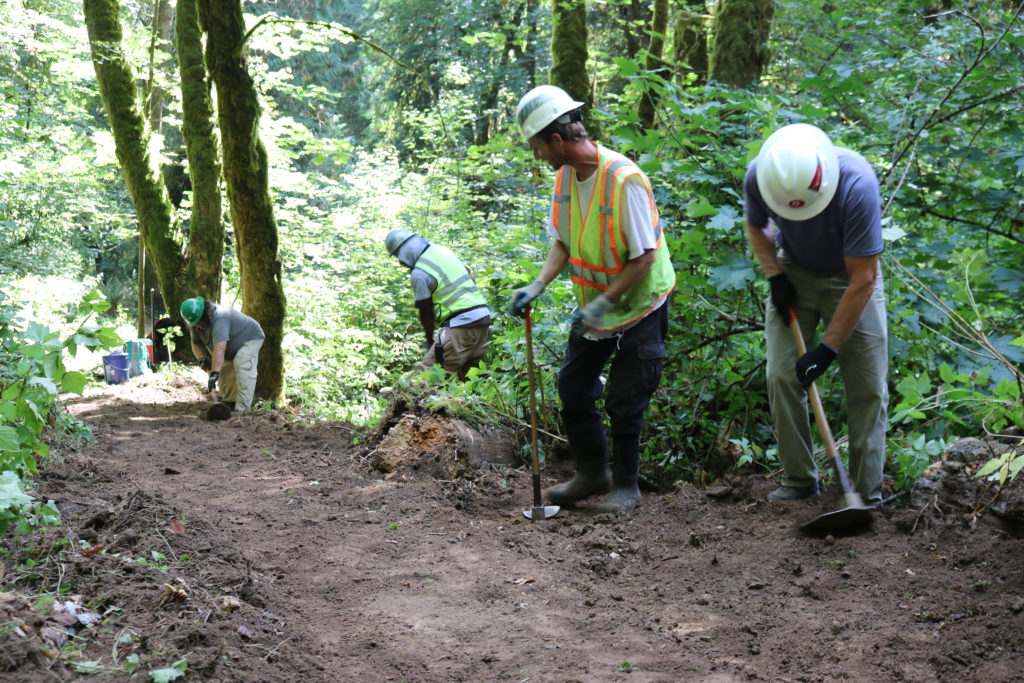The WSU Vancouver “Cougs in the Community” program, designed to connect students with local community engagement opportunities and the Development and Alumni Relations office recently coordinated with the Washington Trails Association (WTA) to realign three sections of the Vancouver campus “Cougar Trails.”
Andre Blanco was one of two WSU Vancouver groundskeepers to join the Sept. 22 work party. Staff members from campus Information Technology and Finance offices also attended, deviating outside of the scope of their regular work duties.

Any patch, any flower bed, any big field you see on campus… I’ve touched,” Blanco said confidently, leaning against the handle of his grub hoe waiting for the trail work to begin. Stasia Honnold, WTA’s Southwest regional trails coordinator, lead the crew for the day. Working with the association since March, Honnold explained how prior to this assignment she worked with young adults doing conservation corp work
“The trail is in the middle of what looks like an old road, right in a low spot where the water wants to run down the middle of the trail,” Honnold said, referencing a section of the trail in realignment area C. “We’re going to work to move parts of it to the outside slope so it’s a more sustainable, watershedding trail.”
Honnold laid out the day’s mission, which included working on realignment area C, a section of trail stretching 550 feet south of 159th Street, on Mill Creek’s western bank. She invited the four WTA volunteer assistant crew leaders to introduce the trail tools. Putting on red, white and green safety helmets, the group of 17 attendees formed a circle for introductions and training from the more experienced volunteers.

Among the group were alumni and retirees who have first-aid certifications and lots of trail work parties under their belts.
“During the week, probably 70 percent of the volunteers are retired,” said Lee Young, one of the four volunteer assistant crew leaders, adding, “It’s nice to see so many new faces.”
Fueled by coffee and donuts, the group departed from the gray two parking lot for a 10 minute walk into the wilderness on the Mill Creek Riparian Interpretive Trail.
The narrow trail was decorated with small wooden bridges, infographic signs and equipment meant to “preserve a healthy environment for the fish, wildlife and people who live in and along the creek,” according to the WSU Vancouver website. The area is designed to “expand our knowledge and understanding of the ecological functions of plant and soil systems that border a waterway,” the website says of the trail’s history.

“It’s really sweet to be able to work on trails that so many people use on a daily basis, that are available for people who don’t want to travel super far to get to nature,” Honnold said.
For three hours on the morning of Sept. 22 the work party carved drainage channels, replanted ferns and reshaped the dirt, moving the trail closer to the edge of the creek where water would more easily shed. According to Honnold, a previous WTA work party on Sept. 13 addressed realignment areas A and B, located on the other side of the creek, that were at one point eroded into the creek.

“Generally speaking, you want trails in the Northwest to be situated where they can shed water as quickly as possible,” Honnold said. “Otherwise, if water stays on the trail, the trails become creeks or mud pits.”
Honnold said WTA’s success relies largely on “trip report” data submitted to WTA’s website. Northwest hikers have posted over 132 thousand reports since the WTA website began accepting them in 1996.
“If you see a fallen tree or a worn trail, submit a trip report,” Honnold said. “If it’s public access, we’ll consider working on it.”
Further coverage, including additional photos and maps of the Sept. 22 volunteer work party and the WSU Vancouver trails can be found online at thevancougar.com
